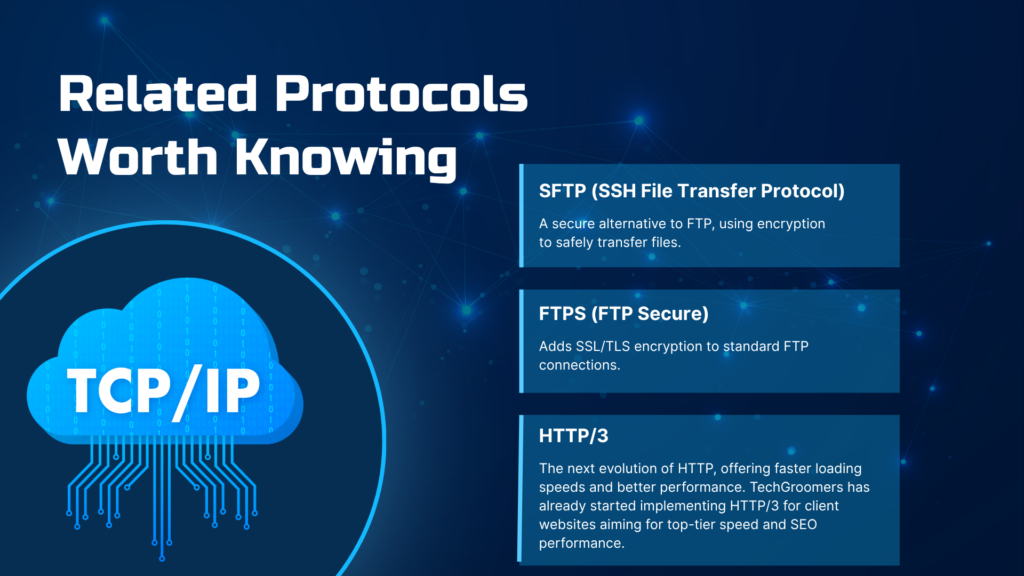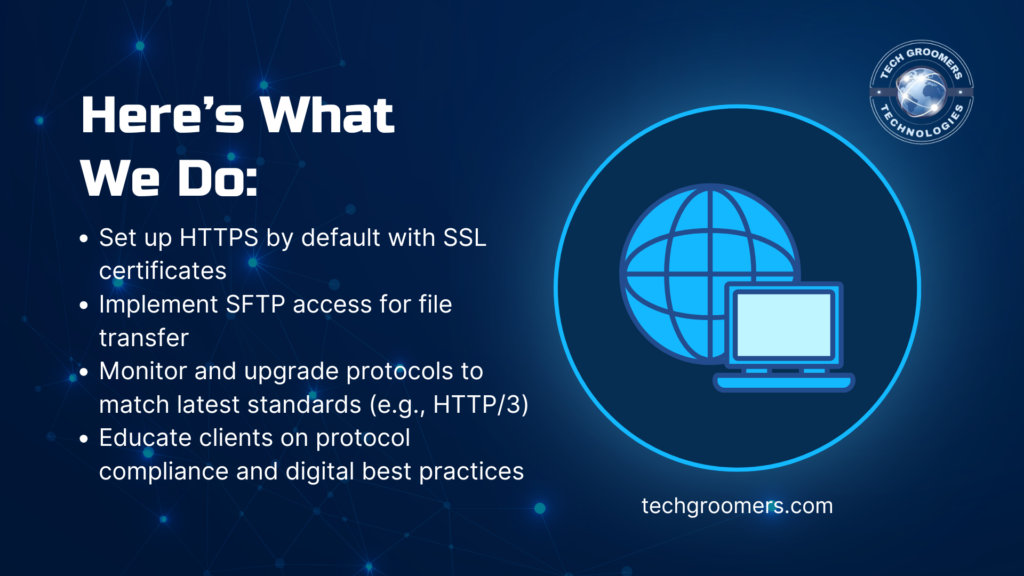Ever wondered what those letters at the beginning of a web address actually mean? Whether it’s HTTP, HTTPS, or FTP, these terms are more than just digital jargon. They form the foundation of how we access and interact with content on the internet. In this TechGroomers blog, we’ll simplify these web protocols, explain how they differ, and why they matter more than ever in 2025.
What Are Web Protocols?
In simple terms, web protocols are standardized rules that allow devices to communicate over the internet. These protocols govern how data is sent and received, making sure your browser can properly load a website or transfer a file. Without these rules, the web would be a chaotic mess.
Think of web protocols as digital traffic rules: they ensure smooth, secure, and accurate transmission of information across the network.
Why Web Protocols Matter in 2025
With rising concerns about data privacy, online security, and fast content delivery, understanding protocols like HTTP, HTTPS, and FTP isn’t just for tech experts anymore. Whether you run a website, shop online, or download files, these protocols directly impact your digital experience.
At TechGroomers, we make it a point to educate clients on core web technologies, helping them build faster, safer, and more reliable digital platforms.
HTTP: The Foundation of the Web
HTTP stands for HyperText Transfer Protocol. It’s the original protocol used for transferring web pages on the internet.
Key Features:
- Text-based protocol used for transferring documents
- Operates on port 80
- Designed for client-server communication
- Not secure – data is sent in plain text
Use Case:
HTTP is often used for public websites where security is not a concern. However, in today’s internet landscape, HTTP is being phased out in favor of more secure alternatives.
HTTPS: The Secure Upgrade
HTTPS stands for HyperText Transfer Protocol Secure. It’s the secure version of HTTP, offering encrypted communication through SSL/TLS certificates.
Key Features:
- Uses port 443
- Encrypts data before transmission
- Protects against man-in-the-middle attacks
- Boosts SEO rankings and builds user trust
Why HTTPS Is Essential:
In 2025, all serious businesses use HTTPS. Browsers like Chrome label HTTP sites as “Not Secure,” which can drive users away. At TechGroomers, we always recommend and implement HTTPS on every client website for better security, trust, and visibility.
FTP: File Transfer Protocol
FTP, or File Transfer Protocol, is used to transfer files between computers over the internet.
Key Features:
- Operates on port 21
- Allows file uploads/downloads from a server
- Can be accessed using FTP clients like FileZilla
- Doesn’t encrypt data by default (but FTPS and SFTP do)
Use Case:
FTP is popular among web developers, hosting providers, and IT teams for managing website files. If you’re editing site files directly, FTP access is a must.
Key Differences Between HTTP, HTTPS, and FTP
| Feature | HTTP | HTTPS | FTP |
|---|---|---|---|
| Security | Low | High (SSL/TLS encrypted) | Low (unless FTPS/SFTP) |
| Port Number | 80 | 443 | 21 |
| Use Case | Browsing | Secure web browsing | File transfer |
| SEO Benefits | None | Yes | No |
| Browser Warning | Yes | No | No |
Related Protocols Worth Knowing

In addition to the big three, you should be aware of these related protocols:
SFTP (SSH File Transfer Protocol):
A secure alternative to FTP, using encryption to safely transfer files.
FTPS (FTP Secure):
Adds SSL/TLS encryption to standard FTP connections.
HTTP/3:
The next evolution of HTTP, offering faster loading speeds and better performance. TechGroomers has already started implementing HTTP/3 for client websites aiming for top-tier speed and SEO performance.
How TechGroomers Implements Secure Protocols
At TechGroomers, we don’t just design beautiful websites—we ensure they are built on secure, scalable, and future-ready foundations.

Here’s What We Do:
- Set up HTTPS by default with SSL certificates
- Implement SFTP access for file transfer
- Monitor and upgrade protocols to match latest standards (e.g., HTTP/3)
- Educate clients on protocol compliance and digital best practices
Security and speed go hand in hand. Our web development and hosting practices make sure that your site doesn’t just look good — it performs reliably.
Final Thoughts
Understanding the difference between HTTP, HTTPS, and FTP may seem technical, but it’s crucial for anyone building or managing an online presence in 2025. These web protocols impact your site’s speed, security, and credibility.
At TechGroomers, we empower businesses to make informed digital decisions. Want to upgrade your site to HTTPS or streamline file management with SFTP? Get in touch with us today and future-proof your digital foundation.
Stay secure. Stay optimized. Stay ahead — with TechGroomers.




Leave a Reply